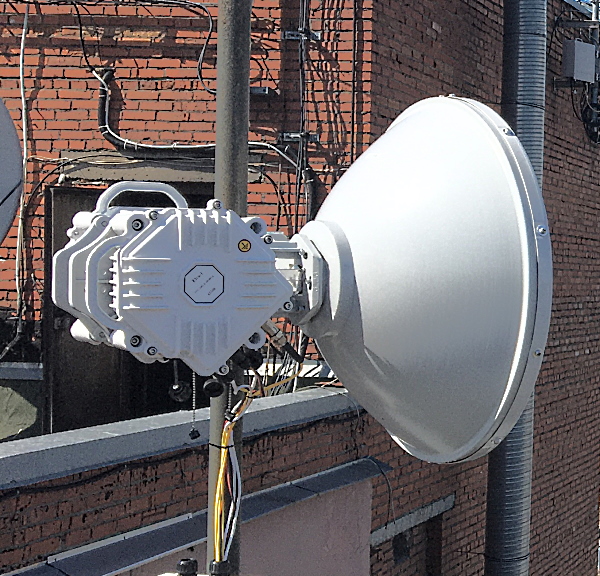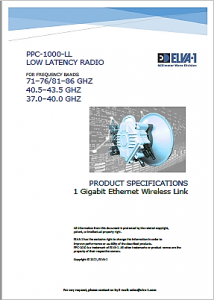 In response to demands from Ultra Low Latency networking market for High-Frequency Trading (HFT) applications, ELVA-1 produces PPC-1000-LL (Low Latency version) 1.25 Gbps Gigabit Ethernet link for FCC-permitted 71-76 / 81-86 GHz (70/80 GHz E-band), 40.5-43.5 GHz (Q-band). and 37.0-40.0 (Ka-band). In terms of network infrastructure, this is the link for Low Latency / Ultra Low Latency wireless networking.
In response to demands from Ultra Low Latency networking market for High-Frequency Trading (HFT) applications, ELVA-1 produces PPC-1000-LL (Low Latency version) 1.25 Gbps Gigabit Ethernet link for FCC-permitted 71-76 / 81-86 GHz (70/80 GHz E-band), 40.5-43.5 GHz (Q-band). and 37.0-40.0 (Ka-band). In terms of network infrastructure, this is the link for Low Latency / Ultra Low Latency wireless networking.
- 45 ns (nanoseconds) latency at zero wireless path distance which is 1,000 times lower than typical Ethernet radios
- High gain with longest distances within 70/80 GHz, 40.5-43.5 GHz and 37.0-40.0 frequency spectrum
- 1000 Mbps Gigabit Ethernet full duplex by RFC 2544
- Nordic design works well for regions like Alaska, Canada, Northern Europe, South Pole
- Intended for High-Frequency Trading Networks (also known as High-Speed Trading), last mile solutions for networks where transmission speed is crucial.
Practical distances for conditions of ITU rain zone “E”, 2 ft antennas and 99.95% availability of 1 Gigabit full duplex connection:
E-band radio max distance is 7.1 km (4.3 miles)*
Q-band radio max distance is 14.4 km (8.7 miles)*
See also: RFC2544 for PPC-1000-LL by TWS Technologies
* Use the Online link budget calculator to determine actual distances considering frequency band, antenna size and % of connection availability.
 See also: Datasheet for PPC-1000-LL, incl. Specifications and Drawings (PDF),
See also: Datasheet for PPC-1000-LL, incl. Specifications and Drawings (PDF),
Specifications
| Model | PPC-1000-E/LL | PPC-1000-Q/LL | PPC-1000-Ka/LL |
| Frequency range | 71-76/81-86 GHz (E-band) 74-76/84-86 GHz for the Czech Republic |
40.5-43.5 GHz (Q-band) | 37.0-40.0 GHz (Ka-band) |
| Throughput | 1000 Mbps Full duplex | 1000 Mbps Full duplex | 1000 Mbps Full duplex |
| Latency | 45 ns from the SFP socket to the antenna port (on one ODU) | ||
| Channel Bandwidth | 1250 MHz | ||
| Modulation | QPSK | ||
| MTBF | 150 000 hours | ||
| Max Distance * | up to 80.0 km (49.7 miles) with 2 ft antennas at a clear sky |
up to 65.0 km (40.3 miles) with 3 ft antennas at a clear sky |
up to 72.0 km (44.7 miles) with 3 ft antennas at a clear sky |
| Max output power | +27 dBm (500 mW) | +27 dBm (500 mW) | +27 dBm (500 mW) |
| Rx Sensitivity@ 10-9 BER | -64 dBm | -65 dBm | -65 dBm |
| System Gain | 89 dB | 92 dB | 92 dB |
| Management | SNMP v.2; MIB-II and Enterprise MIB; WEB; CLI; Telnet | ||
| Ethernet Interface | 1 × SFP slot (1000Base-X) | ||
| Management Port | 100 Base-Tx (RJ – 45) | ||
| Forward Error Correction | n/a | ||
| Polarization | Vertical / Horizontal | ||
| Antenna Type | Cassegrain-type antenna with radio-transparent radome | ||
| Antenna Gain/Beamwidth for frequency band: | 71-76/81-86 GHz (E-band) | 40.5-43.5 GHz (Q-band) | 37.0-40.0 GHz (Ka-band) |
| 1ft antenna | 45 dB/0.7° | 38 dB/1.5° | 38 dB/1.5° |
| 2ft antenna | 51 dB/0.35° | 44 dB/0.7° | 44 dB/0.7° |
| 3ft antenna | n/a | 47 dB/0.5° | 47 dB/0.5° |
| Power Supply AC | Input 88-132 / 176-264 V, 50/60 Hz |
| Power Consumption | 45 W (60 W when the heater is switched on) per radio |
| DC Power | 36 to 60 V |
| Power Connection | IP-67 |
| Operational Temperature | -50 to +60 °C / -58 to 140 °F |
| Humidity | Up to 100% |
* The line-of-sight is required, installation on high towers is recommended for such long distances.
In High-Frequency Trading (HFT) applications shaving even a single millisecond from trading times can equate to a distinct infrastructure advantage and generate significant profits. According to Information Week Magazine: “A one (1) millisecond advantage in trading applications can be worth $100 million a year to a major brokerage firm”.

